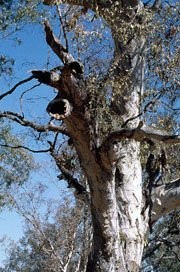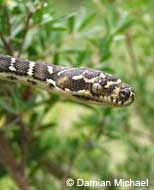About Woodlands
Meet the Animals
Conservation Tips
Puzzles
Further Info
More than 300 species of Australian vertebrates depend on tree hollows for nesting, sheltering or finding food. Animals are very particular about what makes a hollow ‘suitable’ and the majority of occupied hollows, which can often be detected by their smooth, stained entrances, are more than 100 years old. Animals regularly move between many hollow trees to avoid predators and limit parasites. Dead trees with hollows are very important for native animals.


Squirrel Glider Petaurus norfolcensis
The squirrel glider is uncommon and possibly declining because of clearing of woodlands and inappropriate forms of timber harvesting, including firewood collection. Defoliation of trees by insects is also another possible factor contributing to the decline of the squirrel glider. It is found in patches from western Victoria to northern Queensland. It is extinct now in South Australia.
Key habitat needs:The squirrel glider lives in dry eucalypt forest, woodland areas and paperbark swamps. It requires large trees with hollows for nesting and sap nodules from wattle trees to feed on, particularly during winter. Areas with a combination of hollow trees, regenerating eucalypts and understorey wattles are often their most valuable habitats.
Did you know? Marsupial gliding possums need many different hollow trees. They have nesting hollows in many different trees and swap between them to avoid predators such as owls and to avoid fur-living parasitic ticks and fleas.

Carpet Python Morelia spilota metcalfi
The non-venomous carpet python is widespread throughout northern, eastern and south-western Australia. In Victoria the carpet python is a threatened species and is uncommon in parts of southern NSW.
Key habitat needs: The carpet python is mostly a tree-dweller and needs tree hollows and fallen timber for shelter. Mostly active at night or on warm evenings, it feeds on rabbits, rodents, possums, birds and other reptiles.
Did you know? It is often said that snakes like the carpet python can dislocate their jaws in order to swallow a large animal as prey. This is not quite true. In fact, they have an elastic ligament between both sides of the lower jaw near the front, enabling them to expand their mouth, giving the appearance of dislocation.
Skin and internal organs then expand greatly to accommodate a large meal until it is digested.

Sacred Kingfisher Todiramphus sanctus
The sacred kingfisher is common and widespread throughout Australia, particularly along creek lines. The sacred kingfisher is a "latitudinal migrant", breeding in southern Australia in spring and summer and then traveling north in autumn to northern NSw, Queensland, New Guinea and Indonesia. This is opposed to "altitudinal migrants" which move between lower and higher elevations at different times of year.
Key habitat needs: Because it often nests in tree hollows, large eucalypt trees are important habitat requirements. The sacred kingfisher can also dig a nesting burrow in termite nests, in river banks and roadside cuttings.
Did you know? When defending its territory, usually during breeding season, the Sacred Kingfisher will dive and screech loudly at intruders.

This smallest of the black-cockatoo group is found mainly in areas with she-oak trees, typically in eucalypt open forests and woodlands, in Queensland, NSW, Victoria and on Kangaroo Island in South Australia. It is a declining bird and the Kangaroo Island species is critically endangered. Declining numbers are being caused by habitat clearing, removal of large trees for firewood and competition for hollows with introduced honey bees and other native hollow-users such as the common brushtail possum and galah.
Key habitat needs: The Glossy black-cockatoo specialises in eating the protein rich seeds of the she-oak tree. They need deep hollows found in large old eucalypt trees to raise their young.
Did you know? Glossy black-cockatoos are either left or right-footed, with most being left-footed. E.g. birds will use their bills to remove a she-oak cone and then hold it with their left foot to extract the seeds. Their call is a soft wailing "kwee-chuck", "tarr-red" or "merrrve" sound.

Brush-tailed Phascogale Phascogale tapoatafa
The brush-tailed phascogale is uncommon to rare and is thought to be declining due to land clearing, removal of large trees and the impacts of feral predators. Populations are known to exist in Cape York, south-eastern Queensland, the Northern Territory, NSW, Victoria and Western Australia.
Key habitat needs: The brush-tailed phascogale nests in large trees with hollows and often forages for nectar and insects in large flowering trees.
Did you know? Like many mammals, young male brush-tailed phascogales travel far further than females when they are mature enough to leave home. This strategy reduces the chance of matings between close relatives. In contrast, young females often settle close to where they were born and sometimes take over their mother's territory.

